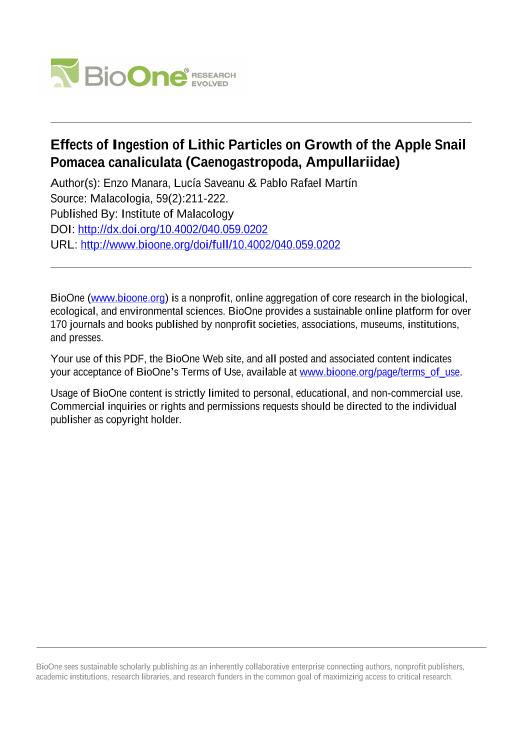Artículo
Effects of Ingestion of Lithic Particles on Growth of the Apple Snail Pomacea canaliculata (Caenogastropoda, Ampullariidae)
Fecha de publicación:
12/2016
Editorial:
Institute of Malacology
Revista:
Malacologia
ISSN:
0076-2997
Idioma:
Inglés
Tipo de recurso:
Artículo publicado
Clasificación temática:
Resumen
Lithic particles are a common feature in the digestive tract of freshwater snails. Their role in the digestive processes has been demonstrated in some microphytophagous and detritivorous species, as they enhance growth, assimilation and reproduction. It has been suggested that they could have the same function in Pomacea canaliculata, a macrophytophagous apple snail with powerful jaws and radula, a strongly muscular and cuticularized gizzard and high levels of enzymatic activity. Our aims were to investigate the occurrence of lithic elements in the digestive tract of P. canaliculata snails from natural populations through the analyses of digestive contents, as well as the effect of size and availability of lithic particles on growth and growth efficiency through laboratory experiments. Lithic particles are very common in the digestive tract of P. canaliculata from natural populations and from laboratory aquaria if they are available in the immediate environment. Such particles are not retained or concentrated differentially in the stomach and they are apparently totally lost in less than four weeks if the supply is interrupted. The frequency of plant material and lithic particles increases from mouth to anus indicating that the retention time increases in the same way. Sand and plant material frequently co-occur in the intestine and in the stomach indicating that both are ingested together. Ground marble had negative effects on the growth of P. canaliculata probably due to the sharp edges and pointed ends of these particles. The availability of natural lithic particles (sand) had a positive effect on growth and also a synergic interaction with the availability of food. The growth efficiency was 25.2% higher when sand was available than when it was absent. These effects were more marked in juvenile females than in juvenile males. Our results indicate that growth rates may be underestimated under laboratory conditions if lithic particles are not supplied regularly and that their presence should be standardized to allow reliable comparisons between studies. Our results also indicate that the effects of food availability and plant palatability on the growth of P. canaliculata may be modulated by the presence of lithic particles and this may in turn affect the outcome of interactions between apple snails, other snails and macrophytes.
Palabras clave:
Invader
,
Feeding
,
Digestion
,
Trophic Ecology
,
Growth Efficiency
Archivos asociados
Licencia
Identificadores
Colecciones
Articulos(INBIOSUR)
Articulos de INSTITUTO DE CIENCIAS BIOLOGICAS Y BIOMEDICAS DEL SUR
Articulos de INSTITUTO DE CIENCIAS BIOLOGICAS Y BIOMEDICAS DEL SUR
Citación
Manara, Enzo; Saveanu, Lucía; Martín, Pablo Rafael; Effects of Ingestion of Lithic Particles on Growth of the Apple Snail Pomacea canaliculata (Caenogastropoda, Ampullariidae); Institute of Malacology; Malacologia; 59; 2; 12-2016; 211-222
Compartir
Altmétricas




